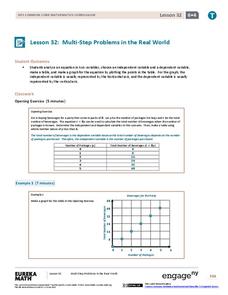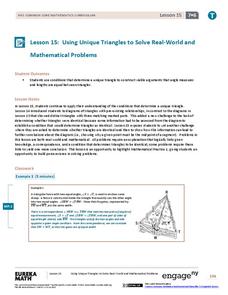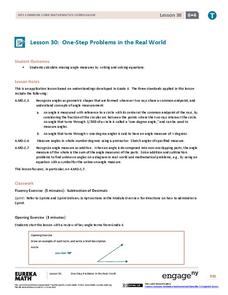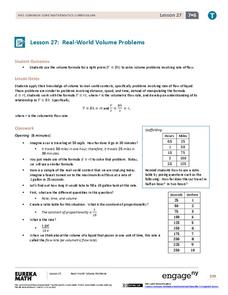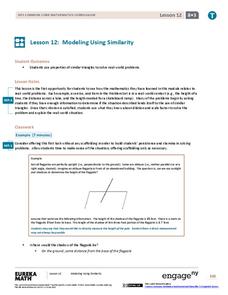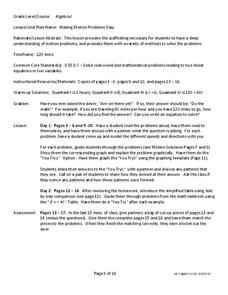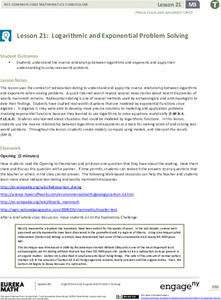EngageNY
Multi-Step Problems in the Real World
Connect graphs, equations, and tables for real-world problems. Young mathematicians analyze relationships to identify independent and dependent variables. These identifications help create tables and graphs for each situation.
EngageNY
Using Unique Triangles to Solve Real-World and Mathematical Problems
How can congruent triangles help mark a soccer field? This is just one question your classes can answer after solving the real-world problems in the lesson. Each example posed through a word problem elicits higher-order thinking and...
EngageNY
Writing and Graphing Inequalities in Real-World Problems
Inequalities: when one solution just doesn't suffice. Individuals learn to write inequalities in real-world contexts and graph solution sets on the number line. All inequalities in the lesson are of the form x < c or x < c.
EngageNY
One-Step Problems in the Real World
Mirror, mirror on the wall, which is the fairest resource of them all? Individuals write and solve one-step equations for problems about angle measurement, including those involving mirrors. Both mathematical and real-world problems are...
EngageNY
Real-World Volume Problems
How long does it take to fill a typical swimming pool? Prepare your pupils to answer similar questions using the 28th lesson in the 29-part module. The engaging lesson asks individuals to solve problems connected to the flow rate. All...
Utah Education Network (UEN)
Real World Equations and Inequalities
Use of the resource = Opportunities for increased learning. Learners must use equations and inequalities to solve real-world and geometric problems.
Central New Mexico Community College
Percent Word Problems
Take young mathematicians' understanding of percents into the real world with this series of word problems. Involving a variety of contexts from calculating scores on math tests and savings account interest, to determining sale prices...
Utah Education Network (UEN)
Analyze Proportional Relationships and Use Them to Solve Real-World Problems
What proportion of learners will benefit from the lessons on proportional reasoning? Class members learn about proportional relationships, from unit rates to writing equations for proportional relationships. Then, they learn to use...
EngageNY
Putting the Law of Cosines and the Law of Sines to Use
Use the Law of Cosines and the Law of Sines to solve problems using the sums of vectors. Pupils work on several different types of real-world problems that can be modeled using triangles with three known measurements. In the process,...
EngageNY
Problems in Mathematical Terms
Whether scholars understand independent and dependent variables depends on you. The 32nd installment of a 36-part series has learners analyze relationships in real-world problems through tables. They determine independent and dependent...
Curated OER
Study Jams! Creating Equations from Word Problems
Word problems are full of information waiting to be deciphered. This animated video explains how to look for the important parts and how to translate those word cues into the correct signs. Go through a problem from start to finish and...
Scholastic
Study Jams! + and - Without Regrouping
Addition and subtraction are essential skills for all young mathematicians. Explain the step-by-step process with respect to place value using these real-world examples. Focus is on numbers in the tens, hundreds, and thousands, making...
Scholastic
Study Jams! Identify Missing or Extra Information
Learn to maneuver through word problems by identifying the specific information needed to solve it. Is there unnecessary information? Is there missing information?
EngageNY
Modeling Using Similarity
How do you find the lengths of items that cannot be directly measured? The 13th installment in a series of 16 has pupils use the similarity content learned in an earlier resource to solve real-world problems. Class members determine...
West Contra Costa Unified School District
Motion Problems
Let's hope class participants don't get motion sickness. In the lesson, class members first solve motion problems using tables and graphs. They then use algebraic techniques to solve motion problems.
Virginia Department of Education
Modeling Division of Fractions
Provide a meaningful context for learning about the division of fractions with this upper-elementary math lesson. Presented with a simple, real-world problem, young mathematicians work in small groups to develop visual models...
EngageNY
Logarithmic and Exponential Problem Solving
Just how old is it? The 22nd portion to a 23-part Precalculus unit uses radiocarbon dating and other exponential modeled real-world problems. Learners use the inverse relationship between logarithms and exponentials to solve the problem...
CK-12 Foundation
Solving Real-World Problems Using Multi-Step Equations: Bowling Ball Delivery
How many bowling balls can a truck carry? A slider interactive changes the weight of boxes and the number of bowling balls per box. Investigating with this slider lets users find the maximum number of bowling balls.
K20 LEARN
Baking Cupcakes!: Fractions
Following an engaging video, mathematicians solve a word problem about baking cupcakes using fractions. Scholars practice different problem-solving strategies, then find different ingredient amounts for their recipes. Pupils solve a...
Flipped Math
Calculus AB/BC - Exponential Models with Differential Equations
Exponential models come with a shortcut. Pupils watch an example of how to determine if a differential equation is an exponential model. Learners realize the solution is in the same formula, allowing for a quick way to determine the...
Illustrative Mathematics
Bank Shot
Young geometers become pool sharks in this analysis of the angles and lengths of a trick shot. By using angles of incidence and reflection to develop similar triangles, learners plan the exact placement of balls to make the shot....
Curated OER
Interpret Clock Time
Save yourself a few minutes of planning with this elementary math instructional activity on elapsed time. Through a series of collaborative and independent learning activities, children explore different real-world situations as they...
iCivics
Step 1: Change the World?
Want to change the world? Where do you begin? Scholars analyze the steps that must take place to make change in society. The first installment of a 10-part County Solutions - High School series brings the real world to the forefront as...
EngageNY
Solving Problems by Function Composition
Stay composed while solving problems. Learners put their knowledge of compositions to solve problems. To connect with the concept, scholars compose equations to answer questions from real-world situations. Finally, pupils practice using...
Other popular searches
- Fraction Real World Problems
- Real World Problems Division
- Math Real World Problems
- Solving Real World Problems
- Real World Problem Solving


